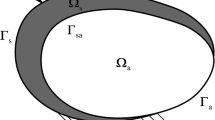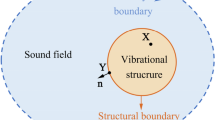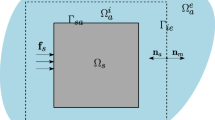Abstract
Continuous linear and quadratic boundary elements are often applied to numerical solution. Discontinuous higher-order boundary elements are developed for 2D acoustic problems to achieve higher accuracy in this paper. The Burton–Miller formulation is used to overcome the fictitious frequency problem when using a single Helmholtz boundary integral equation for exterior boundary-value problem. The strong singular integrals in Burton–Miller formulation using different types of element discretization are evaluated explicitly and directly, respectively. An example of scattering by an infinite rigid cylinder is presented to compare the performance of different types of elements. The effect of the position of nodes on the performance of discontinuous elements is studied, and an empirical value for optimal nodal position is concluded in this paper. Adjoint variable method is applied to evaluate the sensitivity value of the objective function, and the method of moving asymptotes is used for structural optimization analysis of noise barrier.


















Similar content being viewed by others
References
Marburg, S.: Developments in structural-acoustic optimization for passive noise control. Arch. Comput. Methods Eng. 27, 291–370 (2002)
Ratle, A., Berry, A.: Use of genetic algorithms for the vibroacoustic optimization of a plate carrying point-masses. J. Acoust. Soc. Am. 104, 3385–3397 (1998)
Shojaeifard, M.H., Talebitooti, R., Yadollahi, A.: Optimization of sound transmission through laminated composite cylinderical shells using a genetic algorithm. Mech. Compos. Mater. 47, 481–494 (2011)
Hambric, S.A.: Approximation techniques for broad-band acoustic radiated noise design optimization problems. J. Vib. Acoust. 117, 136–144 (1995)
Tinnsten, M., Carlsson, P., Jonsson, M.: Stochastic optimization of acoustic response—a numerical and experimental comparison. Struct. Multidiscipl. Optim. 23, 405–411 (2002)
van Houten, M.H.: Function Approximation Concepts for Multidisciplinary Design Optimization. Dissertation, Technische Universiteit Eindhoven (1998)
Ranjbar, M., Hardtke, H.-J., Fritze, D., Marburg, S.: Finding the best design within limited time: a comparative case study on methods for optimization in structural acoustics. J. Comput. Acoust. 18, 149–164 (2010)
Lamancusa, J.S.: Numerical optimization techniques for structural-acoustic design of rectangular panels. Compos. Struct. 48, 661–675 (1993)
Hambric, S.A.: Sensitivity calculations for broad-band acoustic radiated noise design optimization problems. J. Vib. Acoust. 118, 529–532 (1996)
Marburg, S., Hardtke, H.-J.: Shape optimization of a vehicle hat-shelf: improving acoustic properties for different load-cases by maximizing first eigenfrequency. Compos. Struct. 79, 1943–1957 (2001)
Marburg, S., Hardtke, H.-J.: Efficient optimization of a noise transfer function by modification of a shell structure geometry. Part ii: Application to a vehicle dashboard. Struct. Multidiscipl. Optim. 24, 60–71 (2002)
Haftka, R.T., Adelman, H.M.: Recent developments in structural sensitivity analysis. Struct. Optim. 1, 137–151 (1989)
Marburg, S.: Efficient optimization of a noise transfer function by modification of a shell structure geometry. Part i: Theory. Struct. Multidiscipl. Optim. 24, 51–59 (2002)
Chen, L.L., Chen, H.B., Zheng, C.J.: FEM/wideband FMBEM coupling for fluid-structure interaction problem and 2D acoustic design sensitivity analysis. CMES-Comput. Model. Eng. Sci. 94(6), 459–483 (2013)
Chen, L.L., Zheng, C.J., Chen, H.B.: FEM/wideband FMBEM coupling for structural-acoustic design sensitivity analysis. Comput. Methods Appl. Mech. Eng. 276, 1–19 (2014)
Chen, L.L., Chen, H.B., Zheng, C.J., Marburg, S.: Structural-acoustic sensitivity analysis of radiated sound power using a finite element/discontinuous fast multipole boundary element scheme. Int. J. Numer. Methods Fluids (2016). doi:10.1002/fld.4244
Choi, K.K., Shim, I., Wang, S.: Design sensitivity analysis of structure-induced noise and vibration. J. Vib. Acoust. 119, 173–179 (1997)
Wang, S.: Design sensitivity analysis of noise, vibration and harshness of vehicle body structure. Mech. Struct. Mach. 27, 317–336 (1999)
Chen, L.L., Zheng, C.J., Chen, H.B.: A wideband FMBEM for 2D acoustic design sensitivity analysis based on direct differentiation method. Comput. Mech. 52, 631–648 (2013)
Zheng, C.J., Matsumoto, T., Takahashi, T., Chen, H.B.: Explicit evaluation of hypersingular boundary integral equations for acoustic sensitivity analysis based on direct differentiation method. Eng. Anal. Bound. Elem. 35, 1225–1235 (2011)
Zheng, C.J., Matsumoto, T., Takahashi, T., Chen, H.B.: A wideband fast multipole boundary element method for three dimensional acoustic shape sensitivity analysis based on direct differentiation method. Eng. Anal. Bound. Elem. 36, 361–371 (2012)
Rego Silva, J.J.D.: Acoustic and Elastic Wave Scattering Using Boundary Elements. Computational Mechanics Publications, Southampton (1993)
Tadeu, A., Antonio, J.: Use of constant, linear and quadratic boundary elements in 3d wave diffraction analysis. Eng. Anal. Bound. Elem. 24, 131–144 (2000)
Marburg, S., Schneider, S.: Influence of element types on numeric error for acoustic boundary elements. J. Comput. Acoust. 11, 363–386 (2003)
Marburg, S.: Six boundary elements per wavelength. Is that enough ? J. Comput. Acoust. 10, 25–51 (2002)
Atkinson, K.E.: The Numerical Solution of Integral Equations of the Second Kind. Cambridge University Press, Cambridge (1997)
Burton, A.J., Miller, G.F.: The application of integral equation methods to the numerical solution of some exterior boundary-value problem. Proc. R. Soc. Lond. A 323, 201–210 (1971)
Amini, S.: On the choice of coupling parameter in boundary integral formulations of the acoustic problem. Appl. Anal. 35, 75–92 (1990)
Takashi, I., Kyoji, F.: Performance of noise barriers with various edge shapes and acoustical conditions. Appl. Acoust. 65, 125–141 (2004)
Svanberg, K.: The method of moving asymptotes-a new method for structural optimization. Int. J. Numer. Meth. Eng. 24, 359–373 (1987)
Author information
Authors and Affiliations
Corresponding author
Ethics declarations
Conflict of Interest
We declare that we have no conflict of interest.
Funding
This study was funded by the National Natural Science Foundation of China (Grant nos. 11172291, and U1504505).
Appendix 1: Evaluation of the Integrals on \(S_{\varepsilon }\) and \(\Gamma _{\varepsilon }\)
Appendix 1: Evaluation of the Integrals on \(S_{\varepsilon }\) and \(\Gamma _{\varepsilon }\)
After piecewise discretization, the CBIE and NDBIE formulas can be rewritten as
and
\(S\setminus S_{x^j}\) denotes the boundary S except \( S_{x^j}\), \(S_{x^j}\) is the element containing the source point \(x^j\). \(S_\varepsilon \) denotes a semi-circle with a radius \(\varepsilon \) centred at \(x^j\) and \(\Gamma _\varepsilon \) denotes \(S_{x^j}\setminus S_\varepsilon \).
The function f(x) in every boundary element can be expressed as the following formulation
where m denotes the number of interpolation nodes in every boundary element, \(\Phi \) denotes the interpolation function. Function f(x) could be chosen as \(\phi (x)\), q(x) and so on.
-
1.
For constant element
\(m=1\) and \(\Phi =1\).
-
2.
For linear element
$$\begin{aligned} \Phi _{1}&=\frac{1}{2}\left( 1-\frac{\xi }{\beta }\right) ,\quad \Phi _{2}=\frac{1}{2}\left( 1+\frac{\xi }{\beta }\right) , \end{aligned}$$(38)where \(\xi \) means the local coordinate of the point x, and \(\beta \) denotes the position of interpolation nodes on the discontinuous element. When \(\beta =1\), Eq. (38) denotes expression of the interpolation functions for linear continuous element.
-
3.
For quadratic element.
$$\begin{aligned}&\Phi _{1}=\dfrac{\xi }{2\beta }\left( \dfrac{\xi }{\beta }-1\right) ,\quad \Phi _{2}=1-\dfrac{\xi ^2}{\beta ^2} ,\nonumber \\&\Phi _{3}=\dfrac{\xi }{2\beta }\left( \dfrac{\xi }{\beta }+1\right) . \end{aligned}$$(39)Using Eq. (37) , one can obtain the expression of the coordinate \((x_1,x_2)\) at the point x, as follows
$$\begin{aligned} x_1(\xi )&=\frac{1}{2}A_1 \xi ^2+A_2\xi +{x}^b_1, \end{aligned}$$(40)$$\begin{aligned} x_2(\xi )&=\frac{1}{2}A_3 \xi ^2+A_4 \xi +{x}^b_2, \end{aligned}$$(41)where \({x}^b_k (k=1,2)\) denotes the coordinate of the central point in the boundary element, and the coefficient \(A_k (k=1,4)\) can be derived by
$$\begin{aligned} A_1&={x}^c_1-2{x}^b_1+{x}^a_1, \quad A_2 =\frac{1}{2}({x}^c_1-{x}^a_1), \nonumber \\ A_3&={x}^c_2-2{x}^b_2+{x}^a_2,\quad A_4 =\frac{1}{2}({x}^c_2-{x}^a_2), \end{aligned}$$(42)where \({x}^a_k (k=1,2)\) and \({x}^c_k\) denotes the coordinate of the two extreme points in the boundary element. Similar as linear element, Eq. (39) denotes expression of the interpolation functions for quadratic continuous element when \(\beta =1\).
When different types of elements are used to discretize the boundary, one can obtain the different expression of coefficient \(B(x^j)\) and \(D(x^j)\) in Eqs. (35) and (36), as follows
-
1.
For constant element
$$\begin{aligned} B(x^j)&=-C_1 q(x^j), \end{aligned}$$(43)$$\begin{aligned} D(x^j)&=-C_2\phi (x^j), \end{aligned}$$(44)where coefficient \(C_1\) and \(C_2\) can be expressed as the following formulation
$$\begin{aligned} C_1&= -\frac{L}{2\pi }\left[ \ln (\frac{kL}{2}) -1\right] \nonumber \\&\quad \,+\frac{{\mathrm {i}}}{4}\lim _{\varepsilon \rightarrow 0}\int _{\Gamma _\varepsilon } \left[ H_0^{(1)}(kr)-\frac{2{\mathrm {i}}}{\pi }\ln (kr)\right] \mathrm{d}S(y), \end{aligned}$$(45)$$\begin{aligned} C_2&= \frac{{\mathrm {i}}k^2}{4}\lim _{\varepsilon \rightarrow 0}\int _{\Gamma _\varepsilon } \left[ \frac{ H_1^{(1)}(kr)}{kr} +\frac{2{\mathrm {i}}}{\pi k^2r^2}-\frac{{\mathrm {i}}}{\pi }\ln (kr)\right] \mathrm{d}S(y)\nonumber \\&\quad \,-\frac{k^2L}{4\pi }\left[ \ln \left( \frac{kL}{2}\right) +\frac{8}{k^2L^2}-1\right] , \end{aligned}$$(46)where L is the length of the element in which node \(x^j\) locates.
-
2.
For linear element
$$\begin{aligned} B(x^j)&= - \left[ B_1q(x^j)+B_2q(x^l)\right] , \end{aligned}$$(47)$$\begin{aligned} D(x^j)&=-\left[ D_1\phi (x^j)+D_2\phi (x^l)\right] , \end{aligned}$$(48)where point \(x^l\) is the another node located on a boundary element containing node \(x^j\). \(\alpha \) denotes the local coordinate of the node \(x^j\), and \(\beta =|\alpha |\). For linear discontinuous boundary element \((\beta \ne 1)\), coefficients \(B_1\), \(B_2\), \(D_1\) and \(D_2\) are expressed as following
$$\begin{aligned} B_1&= \frac{{\mathrm {i}}L}{8}\int _{-1}^{1} \big [H_0^1(kr)-\dfrac{2{\mathrm {i}}}{\pi }\ln (kr)\big ]\phi _1 \,d\xi -\dfrac{L}{2\pi }\ln \dfrac{kL}{2}\nonumber \\&\quad \, - \dfrac{L}{8\pi \beta } II_1, \end{aligned}$$(49)$$\begin{aligned} B_2&= \frac{{\mathrm {i}}L}{8}\int _{-1}^{1} \big [H_0^1(kr)-\dfrac{2{\mathrm {i}}}{\pi }\ln (kr)\big ]\phi _2 \,\mathrm{d}\xi \nonumber \\&\quad \,-\dfrac{L}{2\pi }\ln \dfrac{kL}{2} - \dfrac{L}{8\pi \beta } II_2, \end{aligned}$$(50)$$\begin{aligned} D_1&=\dfrac{{\mathrm {i}}k^2L}{8}\int _{-1}^{1}\Big [ \dfrac{H_1^1(kr)}{kr}+\dfrac{8{\mathrm {i}}}{\pi k^2L^2}\dfrac{1}{(\xi -\alpha )^2}\nonumber \\&\quad \,-\dfrac{{\mathrm {i}}}{\pi } \ln (kr) \Big ]\,\mathrm{d}\xi +\dfrac{\ln (1+\beta ) - \ln (1-\beta )}{2\beta \pi L} \nonumber \\&\quad \,-\dfrac{k^2L}{4\pi }\ln \dfrac{kL}{2} -\dfrac{k^2L}{8\pi }II_1 \end{aligned}$$(51)$$\begin{aligned} D_2&=\dfrac{{\mathrm {i}}k^2L}{8}\int _{-1}^{1}\Big [ \dfrac{H_1^1(kr)}{kr}+\dfrac{8{\mathrm {i}}}{\pi k^2L^2}\dfrac{1}{(\xi -\alpha )^2}\nonumber \\ {}&-\dfrac{{\mathrm {i}}}{\pi } \ln (kr) \Big ]\,\mathrm{d}\xi \nonumber \\&\quad \, +\dfrac{\ln (1+\beta ) - \ln (1-\beta )}{2\beta \pi L} - \dfrac{2}{\pi L(1-\beta ^2)} \nonumber \\&\quad \,-\dfrac{k^2L}{4\pi }\ln \dfrac{kL}{2} -\dfrac{k^2L}{8\pi }II_2, \end{aligned}$$(52)where
$$\begin{aligned} r(\xi )&= \dfrac{L}{2}|\xi -\alpha |, \end{aligned}$$(53)$$\begin{aligned} II_1&= \int _0^{1+\beta }x\ln x\,\mathrm{d}x - \int _0^{1-\beta }x\ln x\,\mathrm{d}x, \end{aligned}$$(54)$$\begin{aligned} II_2&= \int _0^{1-\beta }\ln x\,\mathrm{d}x + \int _0^{1+\beta }\ln x\,\mathrm{d}x \nonumber \\&\quad \,- \dfrac{1}{2\beta } \left( \int _0^{1+\beta }x\ln x\,dx - \int _0^{1-\beta }x\ln x\,\mathrm{d}x\right) . \end{aligned}$$(55)For linear continuous boundary element \((\beta = 1)\), coefficients \(B_1\), \(B_2\), \(D_1\) and \(D_2\) are expressed as following
$$\begin{aligned} B_1&=\frac{{\mathrm {i}}L}{8}\int _{-1}^{1} \big [H_0^1(kr)-\dfrac{2{\mathrm {i}}}{\pi }\ln (kr)\big ]\phi _1 \,\mathrm{d}\xi \nonumber \\&\quad \,-\dfrac{L}{8\pi }(2\ln (kL)-3), \end{aligned}$$(56)$$\begin{aligned} B_2&= \frac{{\mathrm {i}}L}{8}\int _{-1}^{1} \big [H_0^1(kr)-\dfrac{2{\mathrm {i}}}{\pi }\ln (kr)\big ]\phi _2 \,\mathrm{d}\xi \nonumber \\&\quad \,-\dfrac{L}{8\pi }(2\ln (kL)-1), \end{aligned}$$(57)$$\begin{aligned} D_1&=\dfrac{{\mathrm {i}}k^2L}{8}\int _{-1}^{1}\Big [ \dfrac{H_1^1(kr)}{kr}+\dfrac{2{\mathrm {i}}}{\pi k^2r^2}-\dfrac{{\mathrm {i}}}{\pi } \ln (kr) \Big ]\phi _1\,\mathrm{d}\xi \nonumber \\&\quad \,-\dfrac{1}{2\pi L}(1+\ln 2)-\dfrac{k^2L}{16\pi }(2\ln (kL)-3), \end{aligned}$$(58)$$\begin{aligned} D_2&= \dfrac{{\mathrm {i}}k^2L}{8}\int _{-1}^{1}\Big [ \dfrac{H_1^1(kr)}{kr}+\dfrac{2{\mathrm {i}}}{\pi k^2r^2}-\dfrac{{\mathrm {i}}}{\pi } \ln (kr) \Big ]\phi _2\,\mathrm{d}\xi \nonumber \\&\quad \,+\dfrac{\ln 2}{2\pi L}-\dfrac{k^2L}{16\pi }(2\ln (kL)-1). \end{aligned}$$(59) -
3.
For quadratic element
$$\begin{aligned} B(x^j)&= - \left[ B_1q(x^j)+B_2q(x^l)+ B_3q(x^m)\right] , \end{aligned}$$(60)$$\begin{aligned} D(x^j)&=- \left[ D_1\phi (x^j)+D_2\phi (x^l)+D_3\phi (x^m)\right] , \end{aligned}$$(61)where points \(x^l\) and \(x^m\) are the other nodes that are located on a boundary element containing node \(x^j\). For quadratic discontinuous boundary element \((\beta \ne 1)\), coefficients \(B_1\), \(B_2\), \(B_3\), \(D_1\), \(D_2\), \(D_3\) are expressed as following
$$\begin{aligned} B_m&= \frac{{\mathrm {i}}}{4}\int _{-1}^{1} \phi _m \big [H_0^1(kr)J_1-\dfrac{2{\mathrm {i}}}{\pi }\ln (kr_1)J_2\big ] \,\mathrm{d}\xi \nonumber \\&\quad \, -\dfrac{J_2}{2\pi }(\ln k+\ln J_2)\int _{-1}^{1}\phi _m\,\mathrm{d}\xi \nonumber \\&\quad \, -\dfrac{J_2}{2\pi }\int _{-1}^{1}\phi _m \ln \vert \xi -\alpha \vert \,\mathrm{d}\xi ,\quad m=1,2,3, \end{aligned}$$(62)$$\begin{aligned} D_m&= \dfrac{{\mathrm {i}}k^2}{4}\int _{-1}^{1} \phi _m\Big [ \dfrac{H_1^1(kr)}{kr}n_j(x)n_j(y)J_1(\xi )\nonumber \\&\quad \,+\dfrac{2{\mathrm {i}}}{\pi k^2}\dfrac{1}{(\xi -\alpha )^2 J_2}-\dfrac{{\mathrm {i}}}{\pi }\ln (kr_1)J_2 \Big ]\,\mathrm{d}\xi \nonumber \\&\quad \, -\dfrac{k^2J_2}{4\pi }(\ln k+ \ln J_2)\int _{-1}^{1}\phi _m \,\mathrm{d}\xi \nonumber \\&\quad \, +\dfrac{1}{2\pi J_2}\int _{-1}^{1}\dfrac{\phi _m }{(\xi -\alpha )^2}\mathrm{d}\xi \nonumber \\&\quad \, -\dfrac{k^2J_2}{4\pi }\int _{-1}^{1}\phi _m \ln \vert \xi -\alpha \vert \,\mathrm{d}\xi ,\quad m=1,2,3, \end{aligned}$$(63)where
$$\begin{aligned} r^2&=(\xi -\alpha )^2\left\{ \left[ \frac{1}{2}A_1(\xi +\alpha )+A_2 \right] ^2\right. \nonumber \\&\quad \left. +\left[ \frac{1}{2}A_3(\xi +\alpha )+A_4 \right] ^2 \right\} , \end{aligned}$$(64)$$\begin{aligned} r_1^2&= (\xi -\alpha )^2J_2^2, \end{aligned}$$(65)$$\begin{aligned} J_1^2&=(A_1\xi +A_2)^2+(A_3\xi +A_4)^2, \end{aligned}$$(66)$$\begin{aligned} J_2^2&=(A_1\alpha +A_2)^2+(A_3\alpha +A_4)^2. \end{aligned}$$(67)When \(\beta =1\), the coefficients \(B_m\) and \(D_m\) for quadratic continuous element can be obtained using Eqs. (62) and (63).
Rights and permissions
About this article
Cite this article
Chen, L., Liu, L., Zhao, W. et al. 2D Acoustic Design Sensitivity Analysis Based on Adjoint Variable Method Using Different Types of Boundary Elements. Acoust Aust 44, 343–357 (2016). https://doi.org/10.1007/s40857-016-0065-4
Received:
Accepted:
Published:
Issue Date:
DOI: https://doi.org/10.1007/s40857-016-0065-4




